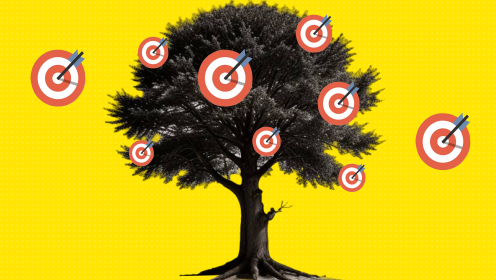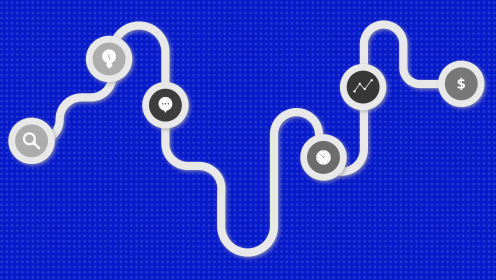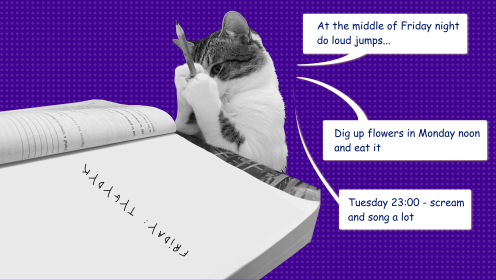If you clearly define areas of responsibility within a team, it helps prevent the common issue of “everyone is responsible, so no one is responsible,” while avoiding missed tasks, lost opportunities, and delayed deadlines. To streamline team roles and responsibilities, RACI and DACI matrices are commonly used.
What is a RACI Matrix
🔹 A RACI matrix is a simple table that clearly defines who is responsible for what within a project.
It’s a common tool in project management, typically created and agreed upon at the start of the project to ensure that team members know their roles and avoid tossing tasks around like a game of hot potato. Each task is assigned to a specific person.
The acronym RACI stands for different roles and levels of responsibility:
R (Responsible). The person directly in charge of completing the task. Every task should have at least one "R."
A (Accountable). The person who has overall ownership of the project. They delegate tasks and approve the final results. Typically, this is a manager or project leader. There should be one "A" for each phase of the project.
❗ While both “responsible” and “accountable” may seem like similar terms, in the RACI framework, there’s a key difference: "Responsible" refers to the person doing the work, while "Accountable" refers to the person who approves the work and takes final responsibility for it.
C (Consulted). An expert whose input is sought before decisions are made. They have the ability to influence the project.
I (Informed). Individuals who are kept up-to-date on the project’s progress. They don’t directly impact the project and are typically updated in a simple “report and proceed” manner.
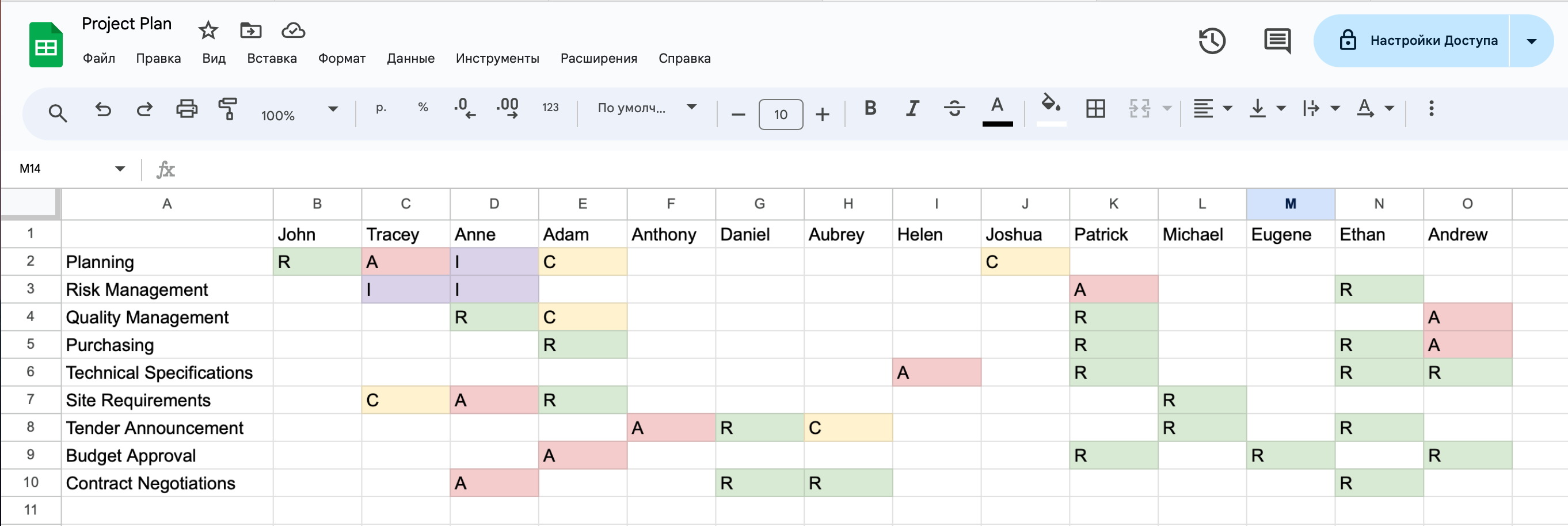
Pros and Cons of RACI
Advantages
✅ Simple and straightforward. The RACI matrix is easy to create and adjust as the project evolves.
✅ Provides a clear plan of action and a breakdown of responsibilities, ensuring everyone knows who is accountable at each stage of the project.
✅ Role clarity. Team members have a clear understanding of their roles and responsibilities, making it easier to know whom to turn to for specific questions or tasks.
✅ Transparency. The matrix offers visibility into everyone’s roles, reducing confusion, duplication of effort, or situations where tasks fall through the cracks.
Disadvantages
❌ Limited scope. While the matrix identifies key roles like consultants and those who need to be informed, it doesn’t specify how communication or collaboration with them should happen.
❌ Challenging for large projects. In complex or long-term projects with many participants, the RACI matrix can become unwieldy. If team members leave or are replaced, updating the matrix can turn into a cumbersome task.
How to Create a RACI Matrix
Let’s walk through creating a RACI matrix using the example of developing a video game.
Project tasks: write the technical specification (TS), design the game, write the code, test the game, and publish it in app stores.
Team members: project manager, designer, developer, tester, and client.
Start by creating a table where tasks are listed vertically, and team members are listed horizontally.
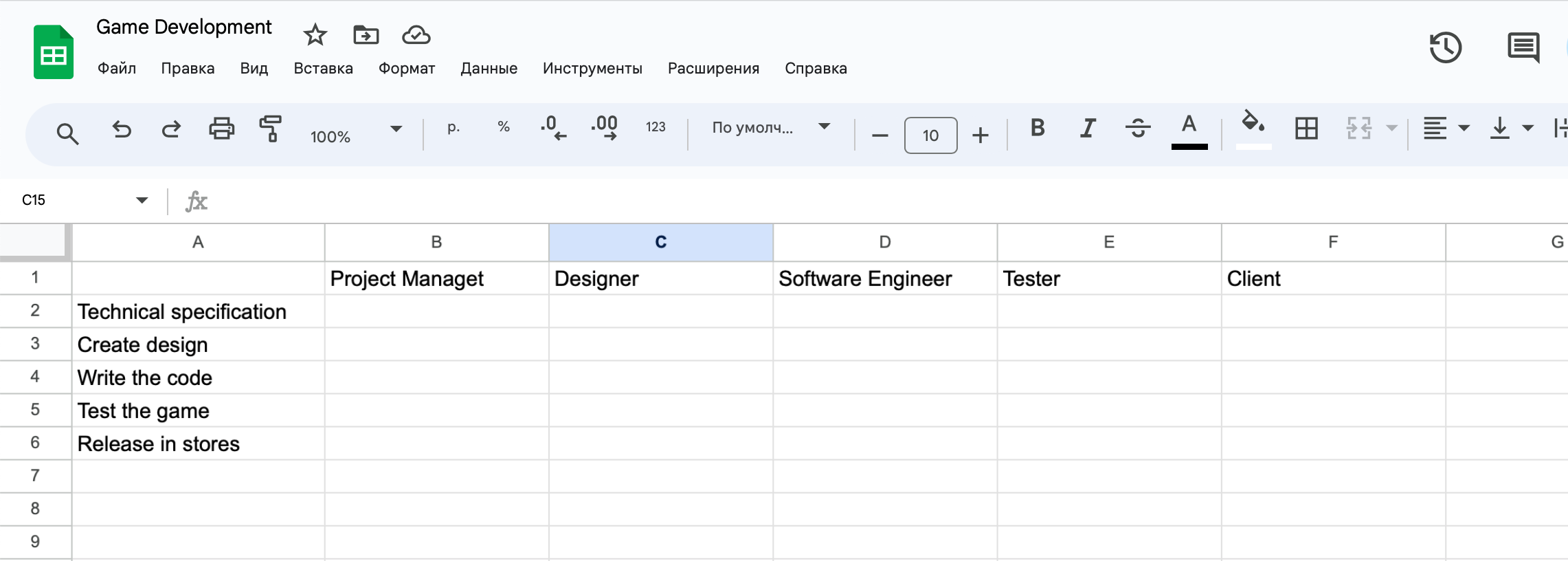
The final step is assigning roles.
R (Responsible). These are the people who will actually execute the tasks:
- The client will write the technical specification.
- The designer will be responsible for creating the game’s design.
- The developer and tester will handle coding and testing.
- The client will also be responsible for publishing the finished game in the app stores.
A (Accountable). In this case, it’s the project manager. All responsible team members will report to the project manager throughout the process. The client, since they are both the executor and responsible for publishing the game, will take on both roles (AR) for that task.
C (Consulted). The designer and developer will act as consultants during the creation of the technical specification, helping the client understand what is feasible and what isn’t.
I (Informed). These are the team members who need to be kept updated. Since the team will work in stages — developer ➡️ tester ➡️ client — each person must notify the next team member when their part of the task is completed.
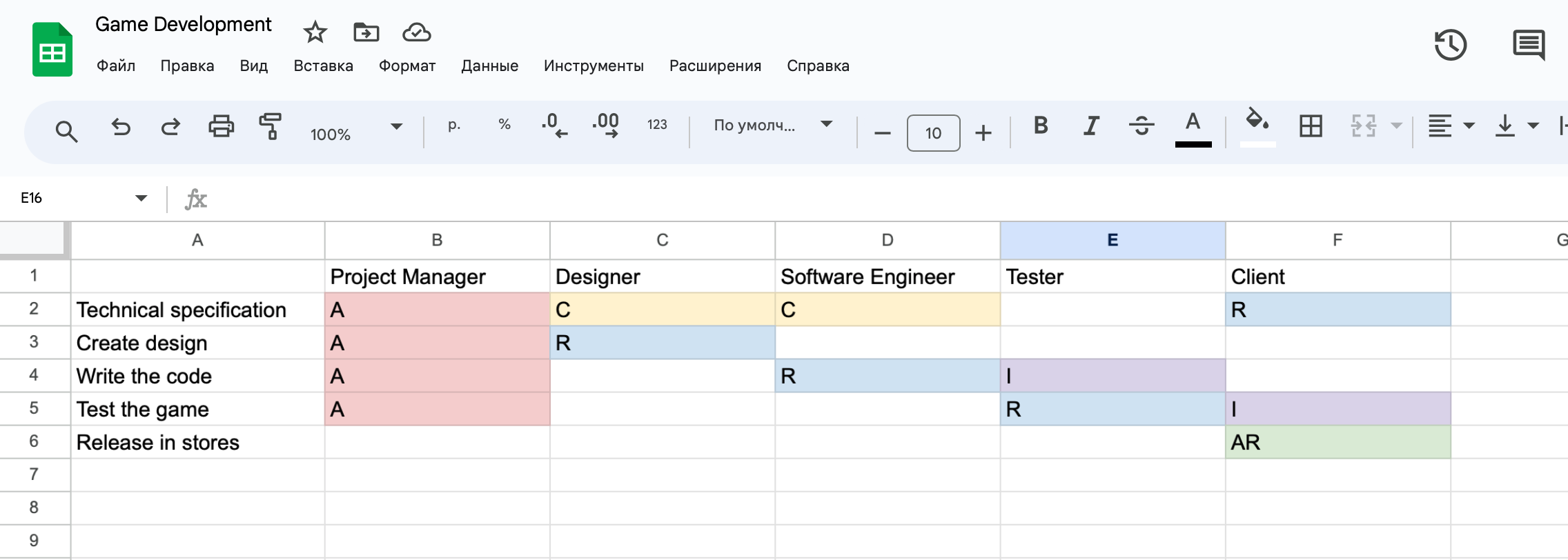
What is the DACI Matrix
🔹 The DACI matrix is a decision-making framework that assigns clear roles and responsibilities for decision-making within a project. While it’s widely used in IT and software development, it can be applied to any fast-paced project.
The acronym DACI breaks down the roles and their levels of responsibility:
D (Driver). The project leader who steers the team and ensures the project stays on track. Typically, there is one driver per project, but larger or more complex projects might have more. The driver’s role includes assigning tasks, setting goals, tracking deadlines, facilitating meetings, and managing documentation.
A (Approver). The person who has the final authority to approve decisions. This is usually a project sponsor or key stakeholder, and they have the ultimate say in decision-making.
❗ It’s best to have only one approver on a project to avoid conflicts and confusion.
C (Contributor). These are the experts who provide input to help guide decisions. They can be investors, industry professionals, analysts, or consultants. Their knowledge and insights are crucial in influencing the final outcome.
I (Informed). Individuals who need to be kept updated on the project’s progress and key decisions. Typically, this includes the project team and stakeholders.
How to Apply the DACI Matrix
Let’s create a DACI matrix using the example of launching a website.
Project tasks: write the technical specification (TS), design the web pages, develop the code, run a marketing campaign, test the finished website, and launch it live.
Project participants: project manager, analyst, owner, web designer, developer, and marketing coordinator.
Start by making a table, listing roles vertically and tasks horizontally.

Once the table is set up, assign each team member to their role in the project for every task.

The DACI matrix is especially helpful in:
- Large-scale projects involving multiple teams or departments. It clarifies roles and improves communication across the project.
- New or large teams. It helps establish a clear project structure right from the start, ensuring a smoother workflow.
- Projects with a lot of uncertainty. It reduces risks and makes the project’s progress more predictable and easier to manage.
RACI vs DACI
While the RACI and DACI matrices share similarities, especially with the roles of consultants and informed parties, they have key differences.
💡 RACI is primarily focused on clarifying each team member’s responsibility level, whereas DACI places more emphasis on how decisions are made within the project.
💡 In RACI, the R (Responsible) is the person carrying out the task. In DACI, the D (Driver) is not necessarily the one doing the work but is responsible for leading the decision-making process.
Their applications also differ:
▪️ RACI is best suited for structured projects where roles, task sequencing, and responsibilities need to be clearly defined and assigned to specific individuals. It works well in stable, predictable environments that follow a set framework.
▪️ DACI is often used in Agile projects where maintaining flexibility and making rapid decisions is key. In these projects, the focus is not on the specific tasks but on the ability to quickly adapt to changes in context.
How to Choose the Right Model for Your Project
Both RACI and DACI are effective tools for clarifying roles and responsibilities. The choice between them depends on what your team needs: if the priority is task execution, RACI is the better fit, while DACI is more suited to teams focused on decision-making and adaptability.
| RACI | DACI | |
|---|---|---|
| Accent | Task execution: defines who is responsible for each task in the project. | Decision making: defines who is involved in making key decisions. |
| R — Responsible D — Driver | Directly involved in the project, performing the work. | Manages the process. Ensures everything stays on track, not necessarily the one executing the tasks. |
| A — Accountable А —Approver | Checks the results and is accountable for them. There may be more than one in a project. | Makes the final decision. Usually, only one per project. |
| C — Consultant C — Consultant | People whose opinions are consulted before decisions are made. Can influence the outcome. | People whose opinions are consulted before decisions are made. Can influence the outcome. |
| I — Informed | Should be informed about task progress and decisions made. Not actively involved. | Should be informed about task progress and decisions made. Not actively involved. |
Integrating RACI and DACI Matrices in Project Management
The first step is gathering information during the project planning phase, when the team is being formed and roles are being assigned. This is also when the task pool is outlined.
Next, create the matrix — essentially, a table. Share it with everyone involved, ensuring they understand their responsibilities.
Lastly, keep the table accessible to all team members for easy reference throughout the project.
Both RACI and DACI matrices can be used on the same project.
❗ It’s critical that everyone knows the matrix exists, understands their areas of responsibility, and follows the assigned roles.
Creating Matrices with Google Sheets
Use our templates to build your matrices. You can download them here.
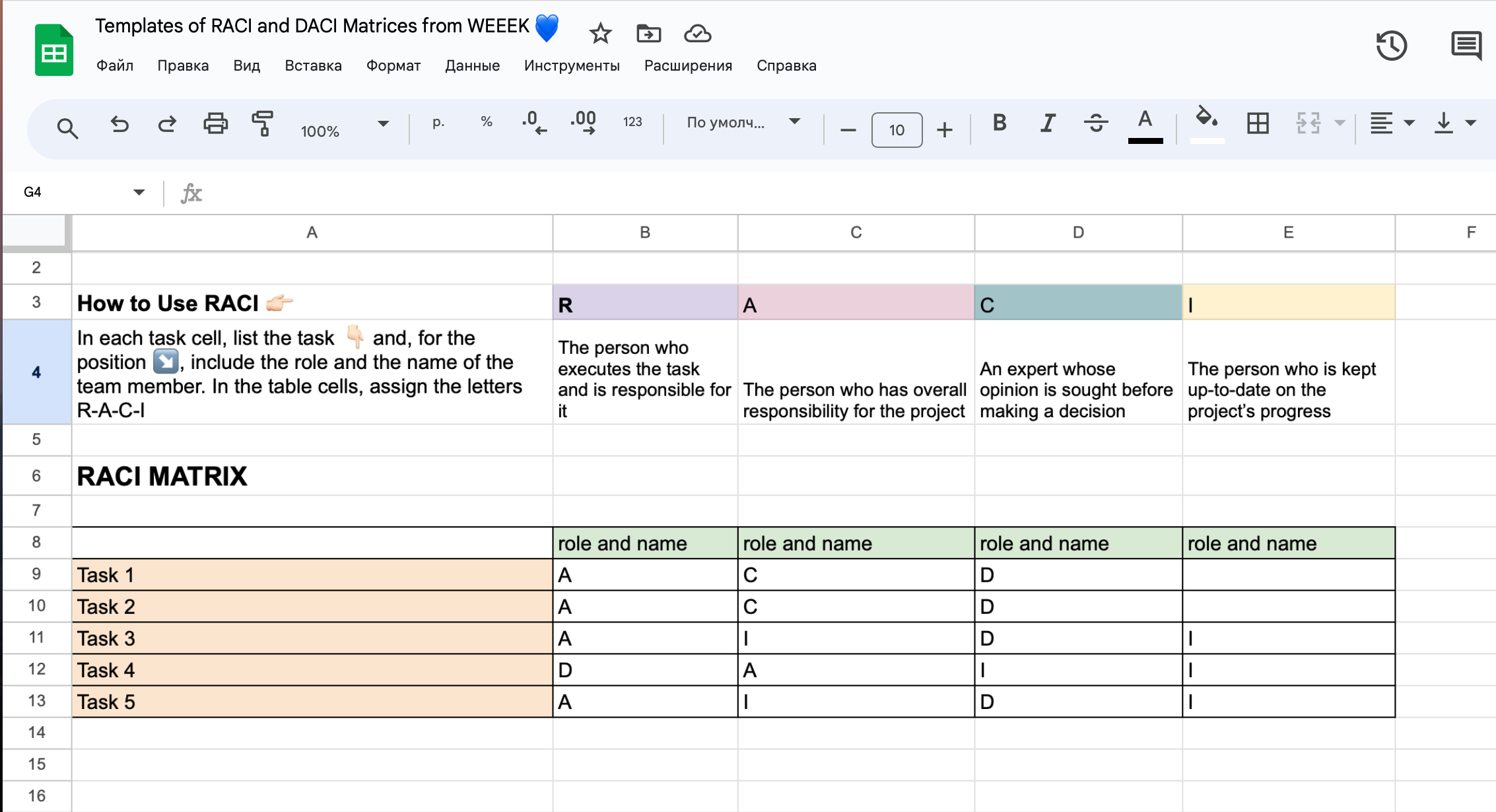
To use them, simply select "Make a copy" under the "File" menu, create a copy in your Google account, and apply them to your projects.
❗ Be sure to share access via a link and keep it alongside other project documentation so the whole team can easily find it.
Creating Matrices with the WEEEK Knowledge Base
We’ve developed an example of a RACI matrix using the WEEEK Knowledge Base.
Our matrix is designed to manage the spare parts ordering process. Since the decision-makers are already identified, RACI fits perfectly.
In the matrix, the stages are listed vertically, and team members are listed horizontally.
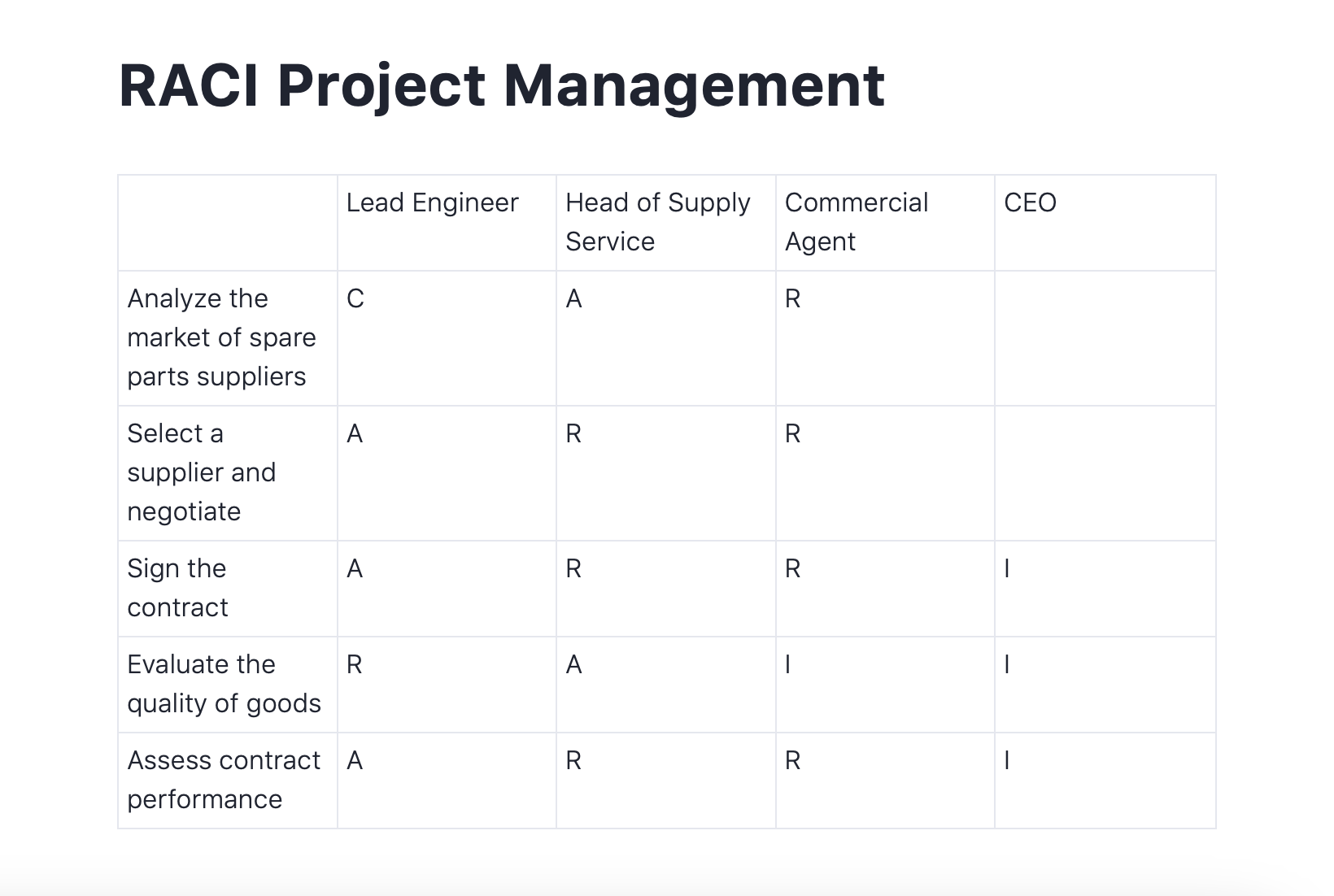
- R (Responsible)
The sales agent will be responsible for market analysis, supplier selection, negotiations, and contract signing. Once the engineer informs the agent about the quality of the delivered parts, the agent will evaluate the contract's fulfillment.
- A (Accountable)
We have two accountable people. The head of procurement oversees the agent's market analysis, while the engineer assesses the quality of the delivered parts. The chief engineer is accountable for the supplier selection, contract signing, and performance evaluation.
- C (Consulted)
The sales agent will consult the chief engineer during the supplier search process.
- I (Informed)
The director will be kept informed about the final three stages — contract signing, performance evaluation, and product assessment. The engineer will notify the sales agent about the condition of the parts, allowing the agent to evaluate contract fulfillment.
RACI Template by Miro
You can download the template via the link provided. This template focuses on areas of responsibility rather than specific project tasks.

❗ Matrices created in Miro can easily be integrated into WEEEK through the "Applications" section for quick access.
Tips for Effectively Using Matrices in Project Management
▪️ Keep the number of consultants minimal—too many people offering input can complicate decision-making and slow things down.
▪️ The matrix works best for projects with 5 to 20 stages. Fewer than 5, and it may not be worth the effort, as creating the matrix could take longer than the project itself. More than 20, and the matrix might become too cumbersome.
▪️ Define each project stage with a clear action, such as “develop design” or “conduct interviews.” Using action verbs makes the process clearer and more dynamic.
▪️ Collaborate on creating the matrix instead of doing it solo. A group approach ensures objectivity and helps avoid missing important details.
▪️ Before finalizing the matrix, ensure that each team member reviews and agrees with their role. This avoids issues with changing responsibilities mid-project.
▪️ Use job titles instead of names when assigning roles in the matrix. This way, if someone is replaced, the matrix stays valid without needing adjustments.
▪️ Take into account the project’s unique needs and choose the appropriate project management methodology, whether it’s Scrum, p3.express, or another suitable framework.
Conclusion — How to Choose the Right Matrix
▪️ The choice between RACI and DACI depends on the complexity of the project, team size, and overall goals. For large, complex projects with many team members, DACI is more suitable. For smaller teams and projects with up to 20 stages, RACI is a better fit.
▪️ RACI is straightforward and effective for managing day-to-day tasks, making it ideal for smaller-scale projects.
▪️ DACI is more detailed and works well for larger projects that require a focus on strategic goals and decision-making.
▪️ Clear distribution of roles and responsibilities is key to a successful project. It helps streamline workflows and ensures deadlines are met without any major disruptions.
▪️ DACI enhances decision-making and keeps the team aligned throughout the project.
▪️ RACI is task-focused, ensuring clarity about who is responsible for each specific action within the project.









